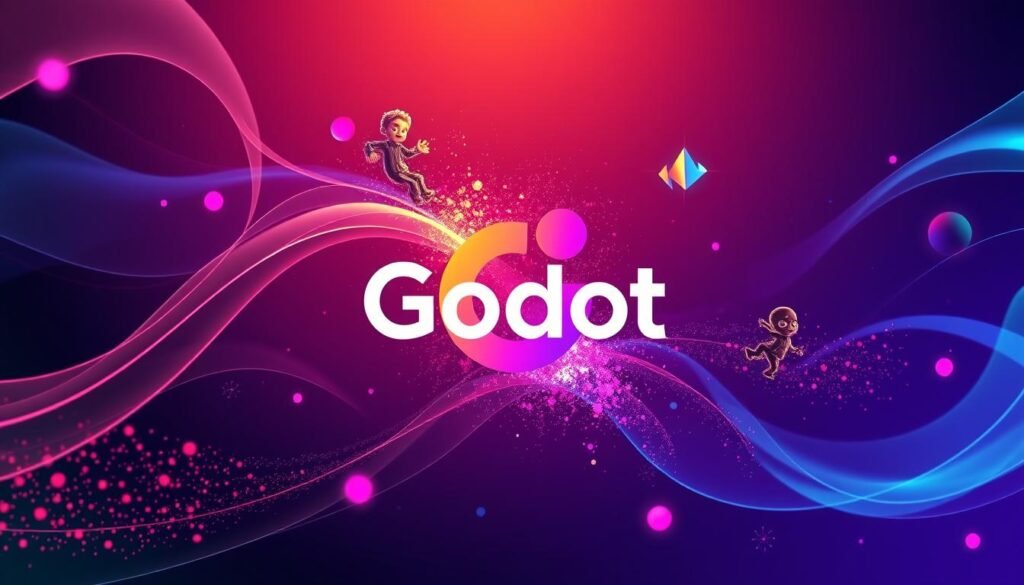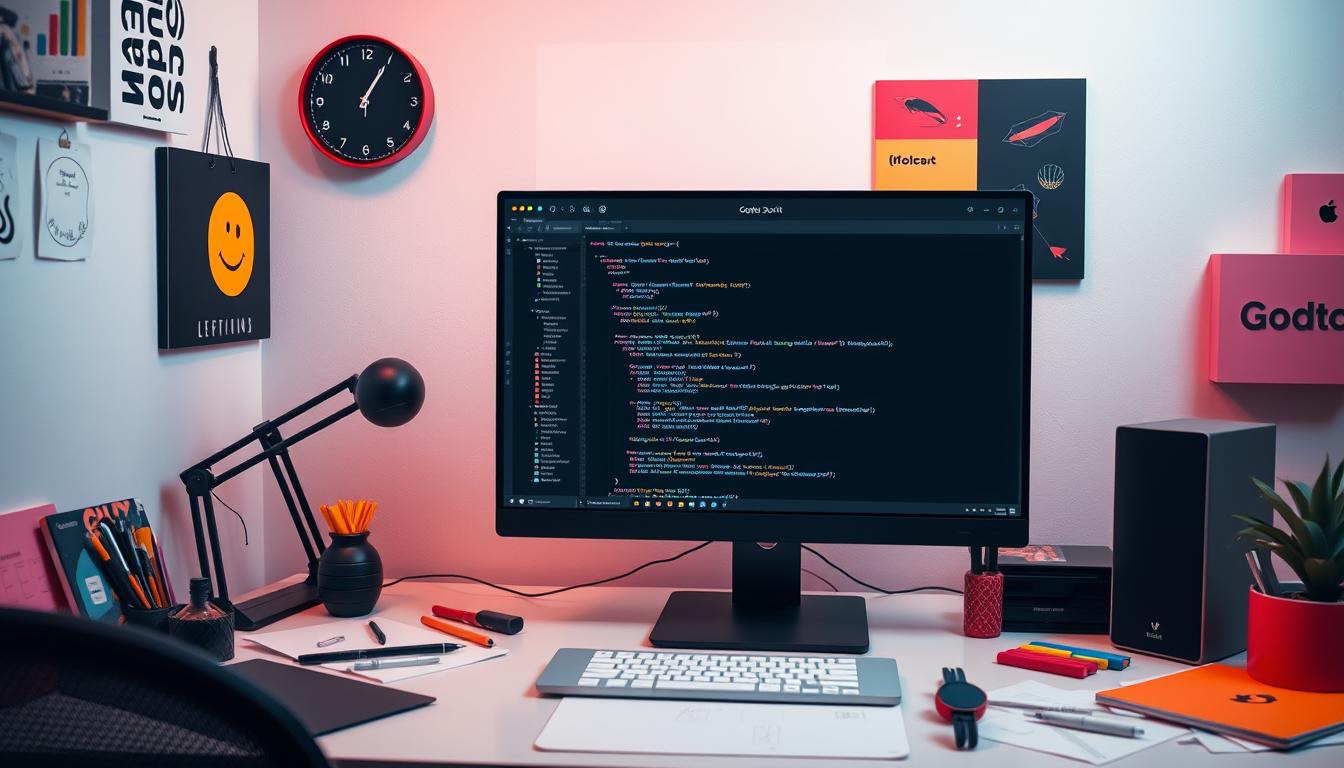The game development world is always changing. The Godot Engine is now a key player, known for making 2D and 3D games. It has many tools to help developers make their games real.
Tutorials are very important. They give you a clear path to learn Godot. They also show you how to make your game-making easier.
This article will show you how to Use Script Template Godot which may help your game-making journey. We’ll cover Godot’s node-based system and how to add cool game features. You’ll learn the key steps to make exciting games with Godot’s scripting tools.
Table of Contents
Key Takeaways
- Discover the power of Godot’s node-based architecture and how it can simplify your game development process.
- Explore the versatility of GDScript, Godot’s Python-like scripting language, and how it can enhance your game’s functionality.
- Learn to create character scenes and implement key attributes and functions to bring your game’s protagonists to life.
- Understand the importance of crafting a dynamic game arena, leveraging Godot’s built-in tools for constructing isometric TileMaps and tilesets.
- Dive into the intricacies of character movement, collisions, and combat mechanics to create engaging gameplay experiences.
Understanding Godot’s Node-Based Architecture
Godot’s game development is built on a unique node-based system. Nodes are the basic parts of any Godot project. They can be sprites, sounds, or scripts. These nodes are grouped into scenes, which is key to Godot’s modular design.
Nodes as Building Blocks
Godot’s node system is great for making games. Each node has its own features, like a name and editable properties. Nodes can be connected, making a tree-like structure for organizing and reusing game elements.
Scenes: Organizing Node Hierarchies
Scenes are groups of nodes that work together. They can be saved, loaded, and even changed to make new versions. The Godot editor helps developers see and change these scene hierarchies.
GDScript: Godot’s Versatile Scripting Language
GDScript is Godot’s scripting language, similar to Python. It’s made for writing game code, with special types like Vectors and Colors. Developers use GDScript to make nodes do more, creating interactive games.
Godot’s design, with its node system, scene management, and scripting, is perfect for game making. Knowing these basics helps developers use Godot to its fullest. They can make games that are engaging, modular, and grow with the game.
| Feature | Description |
|---|---|
| Fully open-source codebase | Godot’s code is fully open source, under the MIT license. This lets the community add and change things a lot. |
| Node-based architecture | Godot’s design lets scenes be built from nodes. Scenes can also inherit from other scenes. |
| Scripting languages | Godot has GDScript and supports C# for game code. GDScript has special types for games. |
| Continuous improvements | Godot gets better with each update. It has thousands of contributors working on it. |
| Flexible rendering | Godot can render 2D in 3D and 3D in 2D. It also lets you put 2D sprites over 3D scenes. |
Creating Your First Character Scene
Starting your first character scene in Godot is exciting. It’s a key step in game development. We’ll show you how to set up a KinematicBody2D for your game’s hero. You’ll learn to add sprites and collision shapes to make your character come alive.
Setting Up the KinematicBody2D
The KinematicBody2D node in Godot is great for character movement and collision. It’s perfect for your game’s main character. To start, create a new node and choose KinematicBody2D. This node will be the base of your character’s scene.
Adding Sprites and Collision Shapes
After setting up the KinematicBody2D, add a Sprite2D node as a child. This will be your character’s look. Use images from the “FileSystem” tab and scale them to fit, like (0.5, 0.5). Also, create a CollisionShape2D node as a child of the KinematicBody2D. This defines your character’s hitbox and collision detection.
| Godot Version | Recommended Practices |
|---|---|
| Godot 4.3 |
|
By following these steps, you’ll have a solid foundation for your character’s scene. It’s ready to be developed further for your 2D games in Godot. Next, we’ll explore adding character attributes and functions.
Implementing Character Attributes and Functions
Let’s look into game development with Godot. We’ll look at character attributes and functions. These are key to our characters’ abilities and actions in the game.
Defining Character Attributes
In our gdscript tutorial, we start with character attributes. These define what our characters can do well and what they struggle with. Attributes like speed, health, and strength are important.
By setting these attributes, we can make many different characters. Each one will have special abilities and challenges. This makes our game more interesting and allows for creative play.
Writing Core Character Functions
Now, let’s make our characters come alive with gdscript. We’ll write functions for actions like attacking and taking damage. These are key for the game’s combat.
Learning to develop these functions helps us make our game better. It ensures players have a great time. This knowledge is a big step in game development with Godot.
“Crafting compelling character attributes and functions is the cornerstone of creating memorable and immersive gaming experiences.”
As we keep learning in the gdscript tutorial, we’ll get better at making our game world. Knowing about character attributes and functions is crucial. It helps us bring our game ideas to life.
script template godot: Jumpstarting Your Game
Starting a new game project can feel overwhelming. But, Godot’s script templates make it easier. They give you a quick start with pre-made scripts and structures. This lets you dive into the fun parts of your game right away.
Godot’s templates work for many game types. You can make tower defense, 2D platformers, or top-down adventures. They come with lots of features, saving you time and effort.
| Template Feature | Details |
|---|---|
| Demo Turrets | The tower defense template has 4 demo turrets. Each turret has its own special features and upgrades. |
| Demo Maps | There are 2 demo maps for tower defense gameplay. |
| Drag and Drop Turret Deployment | It’s easy to place turrets on the map with the drag-and-drop feature. |
| Turret Upgrading and Selling | Players can upgrade or sell turrets as the game goes on. |
| Customization Options | Users can create new turrets with their own stats, upgrades, and looks. |
Godot’s templates aren’t just for tower defense. The 2D platformer template has a great control system. You can adjust gravity, jump speed, and more. The top-down adventure template is perfect for open-world games.
Using these templates, you can start your game quickly. Focus on what makes your game special. Godot’s scripts can open up new possibilities for your game.
Crafting the Game Arena
Exploring 2d games godot and game development godot, we focus on creating an immersive game arena. In Godot, the Isometric TileMap and the engine’s tilesets are key. They help us build a captivating game environment.
Constructing the Isometric TileMap
Godot’s Isometric TileMap lets us build the game arena with pre-designed tiles. We arrange these tiles to create the game world’s landscape, buildings, and more. This method makes development easier and ensures a beautiful game world.
Utilizing Godot’s Built-in Tilesets
We use Godot’s vast library of tilesets to bring our arena to life. These pre-made assets offer many themes and styles. By using these tilesets in our Isometric TileMap, we quickly build the game environment. This saves time and effort in game development.
With the Isometric TileMap and Godot’s tilesets, we create a stunning game arena. This arena is the foundation for an engaging player experience. It’s a solid start for our 2d games godot project.
“The game arena is the foundation upon which the entire game experience is built. By leveraging Godot’s powerful tools, we can create a captivating and immersive environment that captivates players and sets the tone for our 2d games godot.”
Handling Character Movement and Collisions
Making character movement smooth and real is key for any great game. This is true for game development godot and 2d games godot. I’ll show you how to handle movement and collisions in your Godot game.
Godot’s physics engine and KinematicBody2D node help create real character interactions. Let’s explore the key mechanics to make your characters come alive.
Defining Character Movement Attributes
To start, set up your character’s movement attributes in your script. You’ll need to define speed, rotation speed, and movement directions. Don’t forget about gravity and acceleration for natural movements.
Implementing Movement Mechanics
With attributes set, you can build the movement functions. Use move_and_slide() for smooth motion. This method helps your characters move smoothly in the game world. You can use 8-way movement, rotation + movement, or click-and-move mechanics.
Collision Detection and Resolution
It’s important for characters to interact with the game world. Godot’s collision detection lets your characters hit walls, floors, or objects. This makes the game feel real and fun.
Finding the right balance between realism and fun is key. By adjusting movement and collision settings, you’ll create a great 2D game. This game will keep players hooked and engaged.
Introducing Player and NPC Character Types
In the world of 2D or 3D games made with Godot, you’ll find player and NPC characters. We’ll look at making separate scenes for each. These scenes will share a common Character scene. We’ll also talk about how to make each character type different, making the game more fun for players.
Inheriting from the Character Scene
We’ll start with a base Character scene. It will have basic things like movement and looks. This way, we can use the same code for both types of characters.
Our game will have an equal number of player and NPC characters. This makes the game more balanced and exciting. Players will get to interact with both their character and AI characters.
Differentiating Player and NPC Behaviors
Even though they share a base, player and NPC characters will act differently. In our game, we’ve made some key changes:
- Player movement is controlled by four directions. NPCs move randomly, sometimes changing direction.
- The player has 18 health points. NPCs have different health levels, making them harder or easier.
- NPCs have special AI behaviors, like thinking before attacking and reacting differently.
These changes make the game more interesting. Players will need to adjust their strategies for both types of characters.
| Character Attribute | Player Character | NPC Characters |
|---|---|---|
| Movement Control | 4 directional input actions | Randomized pattern with 50% chance of changing direction |
| Max Health | 18 points | Ernie: 15, Bert: 18, Kermit: 40 |
| Additional Behaviors | – | AI-driven “think time” for attacks, delay range based on reflexes |
Using Godot, developers can make games that are fun and challenging. Both player and NPC characters add to the excitement and challenge of 2D games godot, 3D games godot, and game development godot.
Implementing Combat Mechanics
Combat is key in game development. It can make or break the game. In Godot, we’ll learn to make combat fun and dynamic. We’ll focus on damage and adding randomness.
Calculating Damage and Randomization
Damage is crucial in combat. Godot makes it easy with GDScript. We can create a formula that considers strength, defense, and randomness.
We’ll use rand_range() to add surprise to damage. This makes each fight unique and thrilling.
For example, let’s say a character with strength 5 fights one with defense 3. The damage formula is:
- Damage = max(0, Attacker Strength – Defender Defense) + rand_range(-1, 1)
This formula considers strength and defense. It also adds a random value for surprise. This small change can greatly enhance the game.
Mastering damage and randomness makes combat exciting. It keeps players eager for more. This is key to making your gdscript tutorial and game development godot project engaging.
Integrating Animation and Visual Effects

As you explore 2D or 3D game development with Godot, adding cool animations and effects is key. Godot’s animation system, powered by the AnimationPlayer node, helps bring your game to life. It makes characters and combat scenes unforgettable.
Harnessing the Power of Godot’s AnimationPlayer Node
The AnimationPlayer node in Godot is very useful. It lets you make many kinds of animations, from simple movements to complex scenes. You can set keyframes and change values between them for smooth animations.
Godot’s AnimationPlayer node supports many animation tracks. This means you can animate position, rotation, scale, and more. You can even change material colors and audio volume. This control helps you create stunning visuals and sounds.
Adding Visual Flair to Combat
Animations and effects really stand out in combat. Godot’s animation tools make combat scenes more exciting and satisfying.
You can make hit animations with particle effects and sounds for more impact. Use cinematic camera angles and movements for a movie-like feel in combat.
Mastering animation and visual effects in your 2D games godot or 3D games godot makes your game better. It will really grab your players’ attention.
| Godot Animation Features | Description |
|---|---|
| AnimationPlayer Node | Allows creating animations from simple to complex |
| Keyframes and Interpolation | Essential for smooth motion and property changes |
| Animation Tracks | Reference node properties like position, rotation, scale, and more |
| Loop Modes | Clamp and Wrap options for controlling animation behavior |
| Easing Curves | Customize keyframe interpolation for enhanced animation control |
“Animations and visual effects can truly elevate the overall player experience in your Godot-powered games.”
Optimizing Performance and Debugging Techniques
As your godot game engine project gets bigger, making it run fast and finding bugs becomes key. I’ll show you how to make your game faster and use Godot’s tools to find and fix problems.
Measuring and Profiling Game Performance
First, you need to check how well your game runs. Godot 4.3 has tools to help you see how fast your game is. You can use:
- Start/stop timers around code of interest
- Godot’s built-in profiler
- External CPU and GPU profilers/debuggers
- Frame rate checking
- Third-party utilities like RivaTuner Statistics Server and MangoHud
- Unofficial debug menu add-ons
Finding where your game slows down can be hard. It might be the GPU or something else. You need to look closely and try different things to find the problem.
Optimizing Game Performance
After you find where your game slows down, you can make it faster. Here’s how:
- Identify the bottleneck
- Optimize the bottleneck
- Reprofile the game
- Find the next bottleneck to focus on
Start by using the best methods and then make small changes. This way, you can make your game development godot project run much better.
Leveraging Godot’s Debugging Tools
Godot 4.3 has many tools to help you find and fix bugs. You can use:
- Breakpoints creation in the script editor
- Debug options like Break, Continue, Step Over, and Step Into
- Project settings with a dedicated Debug category
- Remote and Local options in the Scene dock for inspecting node parameters
These tools make it easier to find and fix problems. This way, you can make sure your godot game engine project works well.
“Optimization and debugging are essential skills for any game development godot project. With the right techniques and tools, you can ensure your Godot-powered games run at their best, providing a seamless experience for your players.”
Conclusion
We’ve looked into the Godot script template’s amazing features. We’ve seen how the Godot game engine and GDScript work together. We’ve also covered important topics like character movement and visual effects.
Now, you have the tools to make your game development easier. This is true whether you’re new or experienced. The tips in this article will guide you in making great games with Godot.
Keep using the Godot script template as you make games. Stay current with new Godot updates. And always keep learning. With hard work, you can make games that people love. Happy coding!






0 Comments